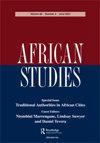Musical figures of enslavement and resistance in Semzaba’s Kiswahili play Tendehogo
IF 1
4区 社会学
Q2 AREA STUDIES
引用次数: 1
Abstract
ABSTRACT This article examines the use of musical figures in a Kiswahili play, Tendehogo. Written by an eminent Tanzanian playwright named Edwin Semzaba, the play recounts how slave trade was conducted by Arab traders in East Africa during the eighteenth and nineteenth centuries. It tells about the experiences of African slave captives being driven by an Arab slave trader away from their homeland in the interior of Tanganyika to the coast. This forced estrangement from their lives as free persons into slavery is accomplished on both physical and mental planes. The article examines how the play uses songs as literary devices, namely musical figures, to represent and enact African and Arab identities, as apparatuses of enslavement and as means of resistance. The article argues that the use of these musical figures in the play Tendehogo sonically mediates readers’ understanding of and attitudes towards East African slave trade and slavery as historical phenomena.塞姆扎巴斯瓦希里语戏剧《Tendehogo》中奴役和抵抗的音乐人物
本文探讨了斯瓦希里语戏剧《Tendehogo》中音乐人物的运用。该剧由坦桑尼亚著名剧作家埃德温·塞姆扎巴(Edwin Semzaba)创作,讲述了18世纪和19世纪阿拉伯商人在东非如何进行奴隶贸易。它讲述了非洲奴隶俘虏被阿拉伯奴隶贩子从坦噶尼喀内陆的家园驱赶到海岸的经历。他们被迫脱离自由人的生活,成为奴隶,这是在身体和精神两个层面上实现的。本文探讨了该剧如何使用歌曲作为文学手段,即音乐人物,来代表和制定非洲和阿拉伯人的身份,作为奴役的工具和抵抗的手段。本文认为,在《Tendehogo》中使用这些音乐人物,从声音上调解了读者对东非奴隶贸易和奴隶制这一历史现象的理解和态度。
本文章由计算机程序翻译,如有差异,请以英文原文为准。
求助全文
约1分钟内获得全文
求助全文

 求助内容:
求助内容: 应助结果提醒方式:
应助结果提醒方式:


